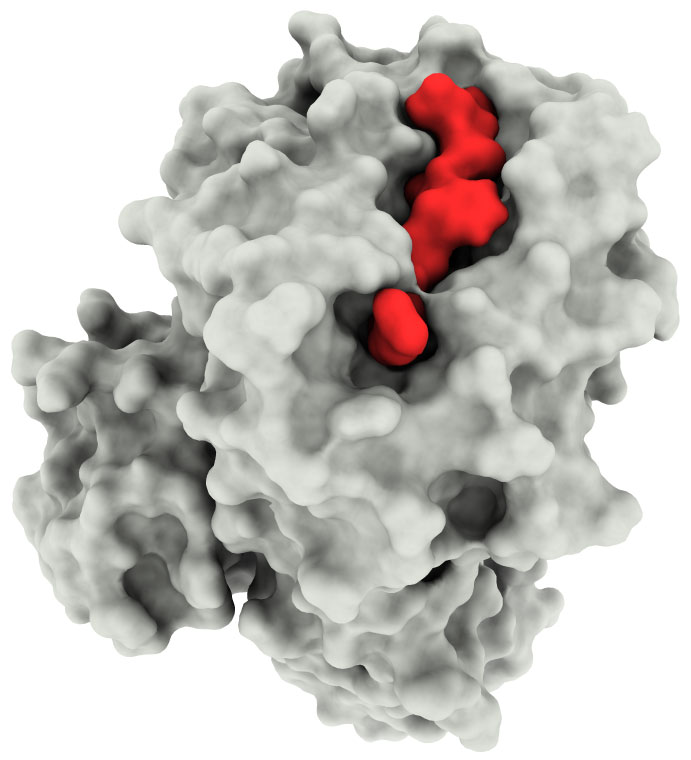Published
March 24, 2020

The Comet
supercomputer at the San Diego Supercomputer Center was used to test
interactions between thousands of pairs of molecules to advance
immunotherapy research aimed at combating cancer. This image depicts a
Human Leucocyte Antigen (HLA) receptor (in grey) that displays a small
protein fragment or peptide (in red) at the surface of a cell. If this
peptide is recognized as “suspicious” by the immune system, the cell
will be destroyed.
Credit: D. Devaurs, Rice University
With the American Cancer Society
estimating 1.76 million new cases and more than 600,000 deaths during
2019 in the U.S. alone, cancer remains a critical healthcare challenge.
In efforts to help mitigate these numbers, researchers at Rice
University used the Comet supercomputer at the San Diego Supercomputer Center (SDSC)
to evaluate their new molecular docking tool, called Docking
INCrementally or DINC, which aims to improve immunotherapy outcomes by
identifying more effective personalized treatments.
Led by postdoctoral researcher Didier Devaurs, the Rice researchers recently published their evaluation of DINC in the BMC Molecular and Cell Biology
journal. The most significant result is that their molecular docking
approach can make predictions of molecular interactions that other
docking tools would miss. This has strong implications in cases where
these predictions are notoriously difficult to make, and especially in
the context of immunotherapy, which leverages the immune system to
combat cancer.
“Immunotherapy is an innovative cancer treatment that has shown
promising results,” said Devaurs. “It consists of ‘training’ a patient’s
cells by recognizing specific tumor-derived peptides, which are
fragments of proteins within a cell.” He further explained that each
cancer patient displays a unique set of tumor-derived proteins and
requires a fully personalized treatment.
The goal of their DINC tool is to assist with identifying these
peptides for cancer immunotherapy, which required significant
high-performance computing resources.
“The computational challenge here is that thousands of tumor-derived
peptides were tested, and each test required exhaustive computing on Comet,” said Devaurs. “Our study showed that Comet
has the computational power to make predictions that could be useful to
immunotherapy. We will next assess how to rank the numerous predictions
it makes to provide only the most realistic ones to our clinician
colleagues working on novel cancer treatments.”
Access to Comet was done via the National Science Foundation’s Extreme Science and Engineering Discovery Environment (XSEDE)
program, under NSF grant ACI-1548562. Additional funding came from the
National Institutes of Health (1R21CA209941-01), the Informatics
Technology for Cancer Research (ITCR) initiative of the National Cancer
Institute (NCI), and the Cancer Prevention & Research Institute of
Texas (RP170508). This work was also supported by a training fellowship
from the Gulf Coast Consortia through the Computational Cancer Biology
Training Program (RP170593).
Molecular structures are depicted by images produced with the PyMOL
Molecular Graphics System, Version 1.8 Schrödinger, LLC. The funding
bodies had no role in the design of the study and collection, analysis,
and interpretation of data, or in writing the manuscript.
About SDSC
As an Organized Unit of the University of California San Diego, SDSC
is considered a leader in data-intensive computing and
cyberinfrastructure, providing resources, services, and expertise to the
national research community, including industry and academia.
Cyberinfrastructure refers to an accessible, integrated network of
computer-based resources and expertise, focused on accelerating
scientific inquiry and discovery. SDSC supports hundreds of
multidisciplinary programs spanning a wide variety of domains, from
earth sciences and biology to astrophysics, bioinformatics, and health
IT. SDSC’s petascale Comet supercomputer is a key resource
within the National Science Foundation’s XSEDE (Extreme Science and
Engineering Discovery Environment) program.


Share